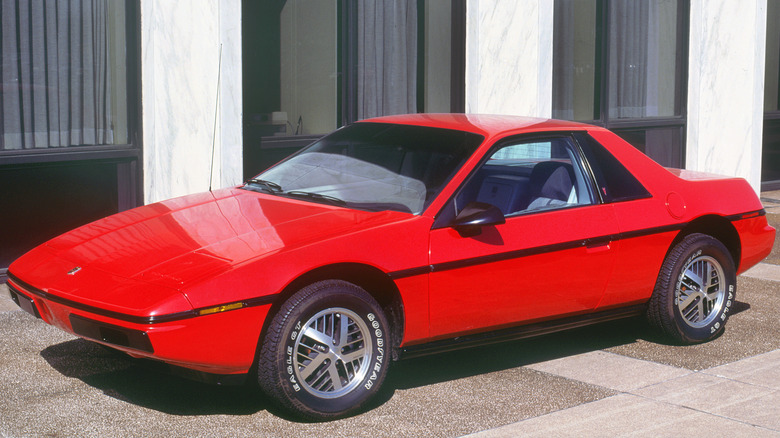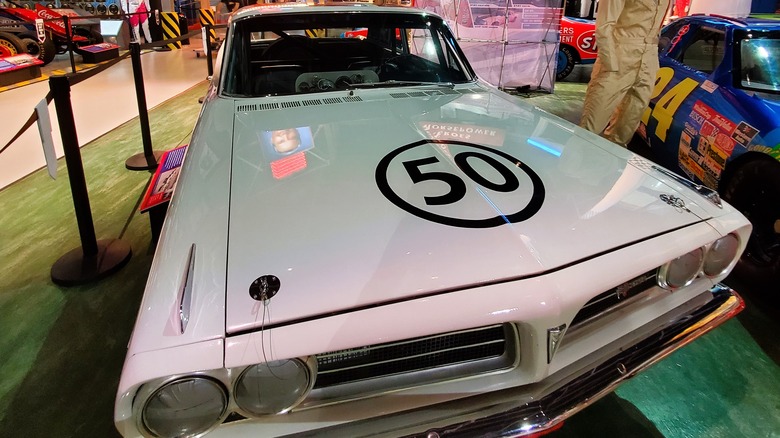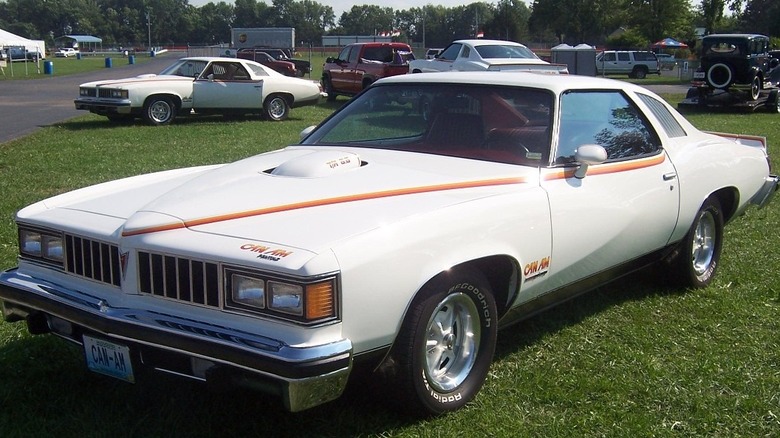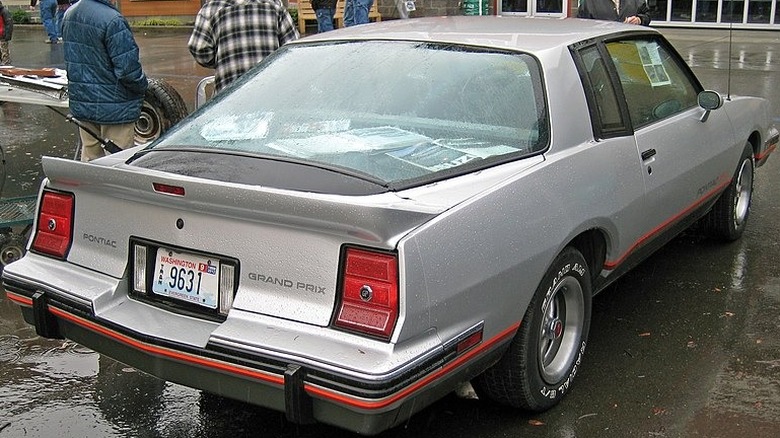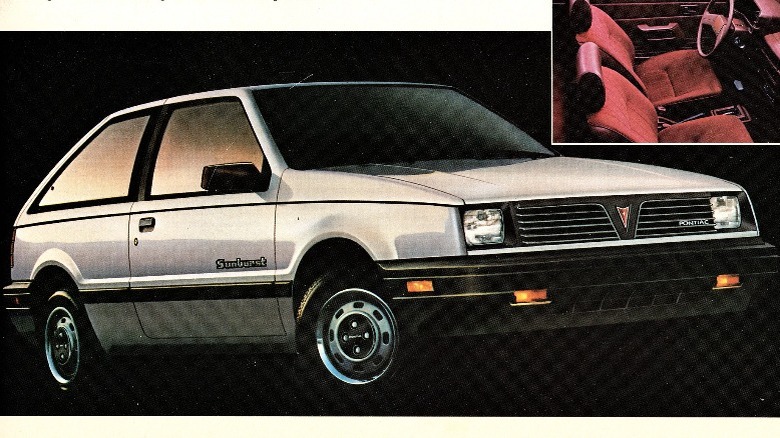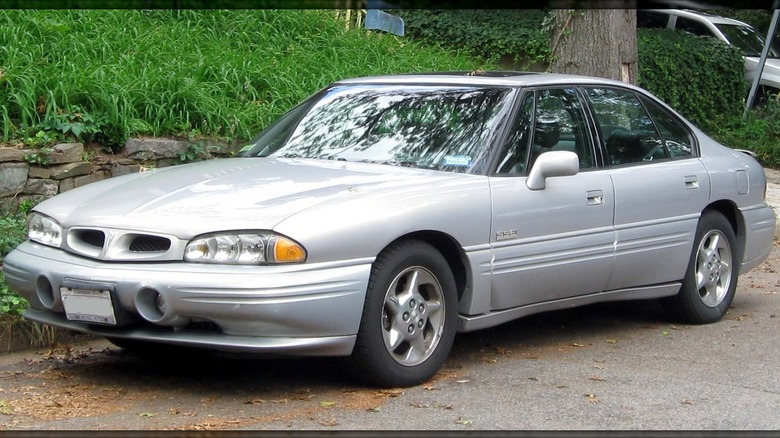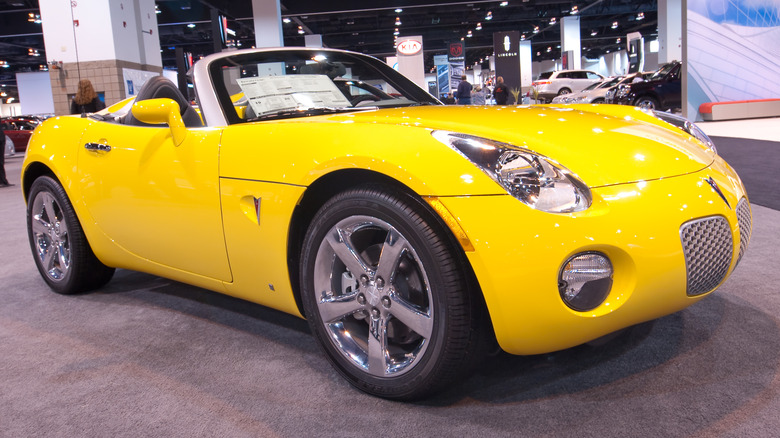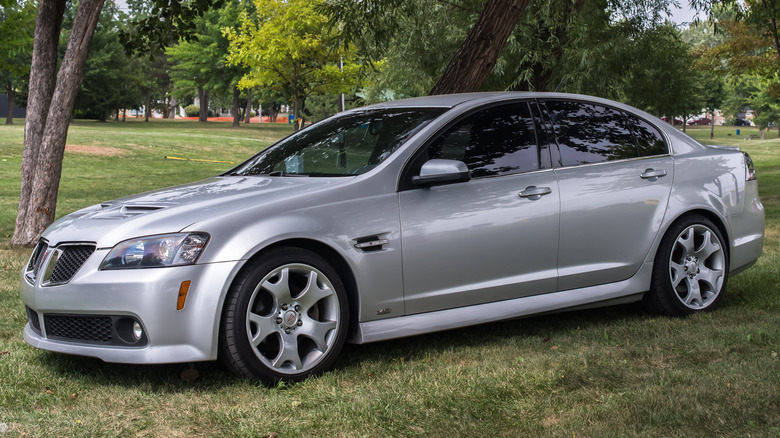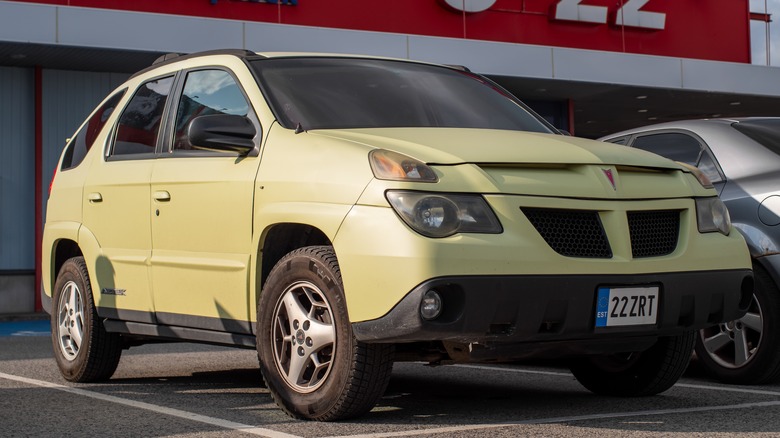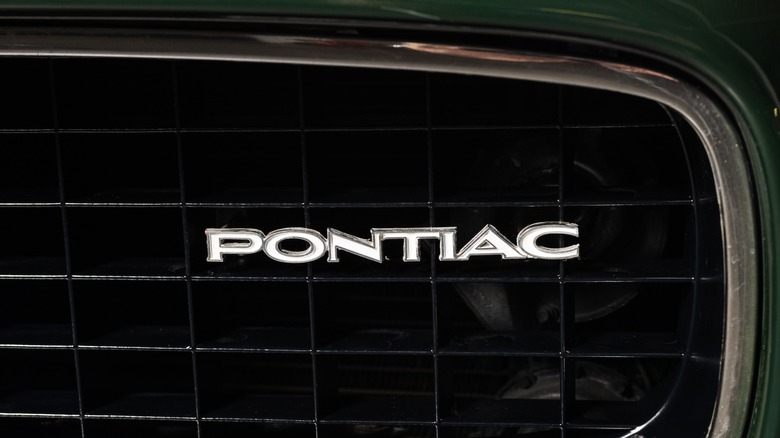10 Of The Strangest Pontiac Models Ever Made
"We build excitement!" This advertising tagline, introduced by Pontiac in the mid-1980s, summed up the company's ambition to be GM's performance division. Alas, Pontiac doesn't build anything anymore, having been shut down by General Motors in 2010. Still, from the first-ever Pontiac car made in 1926 to the last Pontiac ever made, the company built its reputation on style and horsepower.
The final Pontiac, a white G6 sedan, fittingly rests in a museum now, an ordinary monument to an extraordinary past. Even though its performance heritage had been watered down by the end, driving enthusiasts still mourn the company's passing. Some of the most legendary American cars of all time rolled out of Pontiac's factories.
From the 1926 Pontiac Six with its 40 horsepower inline six-cylinder engine, which was exciting for an affordable car in its day, through its muscle car glory years in the 1960s and right up through one of its final performance cars, the G8, Pontiac put power within the average driver's reach. Pontiac muscle cars made an impact on NASCAR tracks and even the drag strip, with vehicles like the "Swiss Cheese" Catalina making history in the National Hot Rod Association (NHRA).
An old song says that all good things must come to an end. After building some of the most iconic sports cars ever made, the Pontiac nameplate has faded into history. However, alongside famous models like the Catalina, GTO, and Trans Am, the carmaker's history also features some oddities. This is perhaps fitting for a brand that took risks and blazed new trails, although not every one of these models can be judged a success. Some of them are classics in their own right, though. What follows are 10 of the strangest Pontiacs ever made.
1961-1963 Pontiac Tempest
The Tempest was part of GM's twin counteroffensive against small, sporty imports along with the Chevy Corvair. With a four-cylinder engine that was literally half of a V8 along with a rear transaxle, it sported a drive train layout that wouldn't be seen in another GM car until the late 1990s. It shared a platform and a 112-inch wheelbase with Buick and Oldsmobile models. This was a stretched version of the rear-engined Corvair's platform, but the similarities ended there. Pontiac went for a cutting-edge approach, starting with its unique drivetrain.
Transaxles combine the transmission and the drive axle into one assembly and are usually found in front-wheel-drive cars rather than rear drivers like the Tempest. A rear transaxle puts more weight on the rear drive wheels for better traction and a nearly 50/50 weight distribution between front and rear. A forged steel torsion bar inside a torque tube transferred power from the engine to the transaxle. This system gained the nickname of "rope drive" but was actually very strong. Its small size nearly eliminated the transmission hump in the floor of the passenger compartment.
Power from the 195 cubic-inch four-cylinder engine under the hood varied based on configuration. Made by cutting Pontiac's 389 V8 in half, it generated as much as 166 horsepower and 215 lb-ft of torque with the four-barrel carburetor option, which sported a 10.25:1 compression ratio. These aren't earth-moving numbers, but in a compact car that barely topped 3,000 pounds fully equipped. This made the Tempest sporty for its day. Pontiac even fielded the Tempest in NASCAR's Cannonball Compact racing circuit.
1977 Can Am
When something or someone is unique people will often say, "After they made such-and-such, they broke the mold." In the case of one extremely rare Pontiac model, they quite literally did that. The 1977 Pontiac Can Am came into being to revive Pontiac's performance heritage during the oil shock-induced automotive malaise of the '70s. One of its distinctive features was its ducktail spoiler, but after only 1,377 Can Ams had been built (or 1,133, depending on your source), the mold for making the spoiler broke, and Can Am production ended.
Why didn't Pontiac just build a new mold? Some theories range from a long delay to build new tooling to internal opposition to the Can Am within Pontiac. It's also possible that there weren't enough of its 400 cubic inch engines to go around at GM, so the broken spoiler mold was a handy excuse to end production. In any event, this resulted in the Can Am becoming one of the rarest Pontiacs ever made. It was also an outlier during its era, as a flashy and eye-catching car that harkened back to Pontiac's muscle-car prime.
In addition to its spoiler, the hood and sides of the car sported red and gold racing stripes, while rally wheels suggested sporty handling. While the Can Am couldn't have carved up a road course like modern cars, models equipped with a special handling package received front and rear stabilizer bars and other upgrades. Combined with 325 lb-ft of torque from its V8, it made a decent showing during an era when driving excitement was hard to come by.
1986 Grand Prix Aerocoupe 2 2
Carmakers often create rare models to qualify for a racing series by building a certain number of street versions of their race car, a process called homologation. This is how the unusual 1986 Grand Prix Aerocoupe 2+2 came to be, as NASCAR once required its cars to resemble models that could be bought in the showroom. However, the regular Grand Prix had a squared-off notchback design with a nearly vertical rear window, which was hardly a recipe for a low drag coefficient.
To solve this problem, Pontiac replaced the rear windshield with a large bubble of glass that sloped down to the ducktail spoiler. Now it had a fastback profile, but one that arguably didn't quite fit with the angular design of the rest of the car. Other drivers at the time probably did double-takes at the sight of this unusual Grand Prix. It almost looks like a hatchback, but that rear glass didn't lift and instead covered a very long rear parcel shelf.
Homologation rules didn't require the cars to resemble their racing counterparts under the hood, and indeed the Aerocoupe was only powered by a 165 horsepower V8. Nevertheless, the Aerocoupe's distinctive profile and its rarity–only 1,225 were ever made–make this odd Pontiac something of a collector's item now.
1985-1989 Pontiac Sunburst
The Pontiac Sunburst? Surely we meant the Sunbird or the Sunfire, right? No, there really was a Pontiac called the Sunburst, a car with Italian style, built in Japan, badged as a Pontiac, and sold only in Canada. The Sunburst is an example of a Pontiac model that was rebadged from another brand, a common phenomenon in Pontiac's last few decades.
In particular, the carmaker was fond of rebadging imports to fight against other imports in the sales charts. In this case, the rebadged car started life as an Isuzu Gemini, known in the U.S. as the I-Mark, a cute little hatchback built by one of Japan's quirkier car manufacturers. Making the Gemini-slash-Sunburst even more unusual, its design was penned by the Italian car stylist Giorgetto Giugiaro. The result is an attractive compact car with clean lines that wouldn't have looked out of place two decades later.
The Sunburst received its pep from either a 1.3-liter or 1.5-liter four-cylinder engine. Handling was decent, ergonomics were excellent, and needless to say, either of those small four-bangers under the hood gave the Sunburst terrific fuel economy. In the U.S., this car was available as the Chevrolet/Geo Spectrum, but the version with the Pontiac grille remains nearly unheard of in the States.
1984-1988 Fiero
Sometimes, we make mistakes. Perhaps there was a situation where more commitment to the moment could have led to a far better outcome. In the automotive world, the Pontiac Fiero is the ultimate example of looking back wistfully.
The Fiero's fame shouldn't obscure what an odd, out-of-left-field car this was for Pontiac. In the mid-'80s, Pontiac played things safe with family cars like the Grand Prix and the Parisienne. The Firebird and its Trans Am derivative were a little more outrageous, even inspiring the original Knight Rider KITT car, but it upheld a pony car tradition. There was simply nothing in Pontiac's DNA that would suggest it could produce anything like a tiny, two-seater, mid-engine sports car.
Its development was so troubled that General Motors almost didn't build the Fiero. When it was finally released for the 1984 model year, it left something to be desired. Yes, the window sticker was cheap with a base price of just $8,500, but so was much of its design. While the Fiero had a very well-built body with import-quality panel gaps, what was under that skin was less impressive. It was a parts-bin car, with suspension parts that came from unloved models like the Chevy Citation and Chevette. Its version of GM's Iron Duke 2.5-liter four-cylinder only produced 92 horsepower, and the manual transmission had only four gears – unimpressive specs even in the '80s.
In later years, the Fiero got better performance specs including two extra cylinders and a five-speed stick shift. Revised styling helped as well, but it was too late. Slow sales led Pontiac to kill the Fiero after just five model years. Perhaps with more money for development, Pontiac's engineers could have produced a dream machine right out of the gate. Alas, we'll never know.
1988-1993 LeMans
Hold on. The LeMans is a storied Pontiac nameplate. Surely it doesn't belong on a list of strangest Pontiac models? You might think so if you've forgotten that Pontiac slapped the LeMans badge onto a compact Korean import in 1988. More accurately, maybe you've repressed the memory.
It's not that the 1988 LeMans was a bad car, but it did not fit the storied heritage of the LeMans name. After all, throughout its history the 24 hours of Le Mans has attracted some of the world's most famous performance cars like the Ford GT40 and the Ferrari 250 GTO. This is what the words Pontiac LeMans called to mind — until 1988, anyway.
The LeMans that Pontiac brought to American shores that year came from Daewoo Motors in Korea, although it was originally designed as an Opel Kadett in Germany. As the Kadett, it actually won the European Car of the Year award a few years earlier. Still, nothing quite like it had ever been sold out of a Pontiac showroom before.
Its odd Euro-inspired economy car looks and its 74 horsepower 1.6-liter four-banger didn't really live up to the LeMans name, but the car proved relatively popular. Pontiac sold almost a quarter of a million of them throughout the model's run, boosted by more powerful engines in 1989 and beyond.
1992-2005 Bonneville SSEi
Take a platform shared with a sedate Buick and a grandfatherly Oldsmobile, attach a Pontiac grille, wrap the car in excessive trim, drop in a supercharged V6, and you've got the Bonneville SSEi. It's the automotive equivalent of dusting a plain potato chip with cayenne pepper. That said it worked pretty well, to judge by how long Pontiac offered this ultimate Bonneville.
Pontiac fans know about the Bonneville SSEi. The alphabet-soup trim designation first graced a 205 horsepower model in 1992. Its power came from bolting a supercharger to GM's famous 3.8-liter V6, boosting its rating by 35 horses over the base version of this engine. By early-'90s standards, this made the Bonneville SSEi a pretty respectable sports sedan, despite its relatively large size. It could even hit 128 mph.
So what makes the Bonneville SSEi strange? Well, beyond dropping a supercharged engine into a car better known for schlepping families around on errands, there was the SSEi model's looks. It sported plenty of body cladding and strakes, a huge spoiler, and very prominent fog lights. The designers wanted you to know this wasn't your Aunt Edna's Pontiac.
In 2000 a much more refined and understated Bonneville SSEi debuted. Horsepower rose to 240, good for a 0-60 run of 7.1 seconds, as Pontiac focused more on the go than the show in what would prove to be the Bonneville's last generation. As with the Fiero, Pontiac saved the best for last, but unlike the Fiero, the Bonneville SSEi had a very respectable run.
2006-2010 Pontiac Solstice
Strange can be beautiful. In one of its final attempts to live up to its "We Build Excitement" tagline, Pontiac unleashed a tiny, voluptuous roadster called the Solstice that was unlike any other model it ever made. This car could drop its top and turn heads, leaving people saying, "What the heck is that? A Pontiac?"
Its curvy sheet metal and cat-like eyes gave it almost a feral look. With its body-colored hardtop on, giving its side windows an angry squint, it looked downright ferocious. Pontiac went for a more organic and wild look for the Solstice compared to the more high-tech appearance of the Saturn Sky with which it shared a platform.
Like the Fiero, the Solstice was a bit of a parts-bin special underneath its aggressive sheet metal. Nevertheless, performance was decent, especially with the 2.0-liter, 260 horsepower turbocharged four-cylinder that debuted in 2007. The electrifying Solstice may have been oddly out of place in the dying Pontiac division, but it staked its claim as one of the underrated gems among modern roadsters.
2008-2009 G8
In 2008, Pontiac replaced two front-wheel-drive and generally family-oriented sedans in its lineup with a fire-breathing, V8-powered, rear-wheel-drive import. Buyers didn't quite understand it, but it did result in one last blaze of glory before the lights went out at Pontiac forever — the future classic G8 sedan.
Beyond the strangeness of replacing front-drive grocery getters with something better suited to chasing down BMWs on the Autobahn, there's the G8's pedigree. Pontiac rebadged a Holden Commodore from GM's Australian division to create the G8, They did this even though Pontiac's previous collaboration with Holden, the 2004 through 2006 GTO, was discontinued due to poor sales after just three model years.
This second Aussie Pontiac was fairly well received. Reviews were generally positive. Car and Driver magazine described it as "spacious, fast, and agile," adding, "It's a looker, and it's surprisingly affordable." In particular, the G8 GT's 6.0-liter, 361 horsepower V8 engine drew praise. With a base price under $30,000, the G8 delivered a lot of bang for the buck.
However, buyers were confused by how it fit in the Pontiac stable. Only about 38,000 units of the G8 were made in its two-year run. As good as it was, the G8 just didn't fit car shoppers' notion of what a Pontiac is, and the G8 couldn't save either itself or Pontiac. The carmaker discontinued it after the 2009 model year, just one year before GM shut down Pontiac itself. It was an impressive swan song for a dying brand.
2001-2005 Aztek
Most people would agree that the Aztek is one of the strangest -– if not the strangest -– Pontiac models of all time. The ultimate example of Pontiac's willingness to take risks with both style and function, the Aztek polarizes people. Those who owned one tended to love it, while those who didn't own one scratched their heads in complete confusion.
The Aztek's tall, ungainly proportions blurred the lines between a minivan, a large hatchback, and an SUV. Its odd snout paired a low Pontiac split grille with two horizontal vents in the leading edge of the hood. This was combined with acres of straked plastic cladding around the Aztek's lower sections, a split window in its colossal hatchback, and side windows that looked like they belonged in a Bauhaus building to create one of the oddest car exteriors ever made anywhere.
Under the skin, though, the Aztek was a very practical vehicle. Optional four-wheel drive turned it into a semi-decent SUV. Many technological features were advanced for the early 2000s, including a driver information center, while nice touches like rear-seat radio controls kept passengers happy. One of the Aztek's neatest features was an electric cooler in the center console for keeping your drinks cold on your way to the trails or a picnic.
The Aztek's owners loved it for these thoughtful details. Plus, let's face it, if you're in the driver's seat, you don't have to look at it. Its ironic status as one of the coolest cars on the "Breaking Bad" TV show boosted its image, too. Make no mistake, though — the Aztek was strange. It's almost the Platonic ideal of automotive strangeness. Its owners' affection for it wasn't enough to earn it a second-generation redesign, and after 2005 it faded away, to be regarded as a cult classic for both good and bad reasons.
Why did we choose these Pontiac models?
Pontiac's history as a carmaker that was willing to take risks makes it easy to identify offbeat models from its lineups over the decades, from the unusual drivetrain layout of the 1961 Tempest to the daring designs of more recent decades like the Fiero and Aztek.
We presented our list of the 10 strangest Pontiacs ever made in roughly chronological order, except for the Aztek. We saved that for last because it's the crowning achievement of Pontiac strangeness from over three-quarters of a century of its history.
